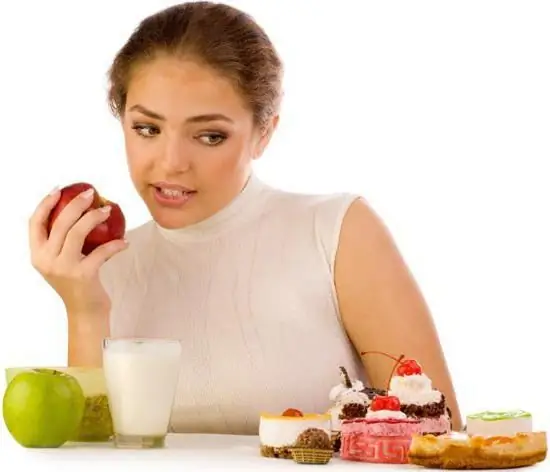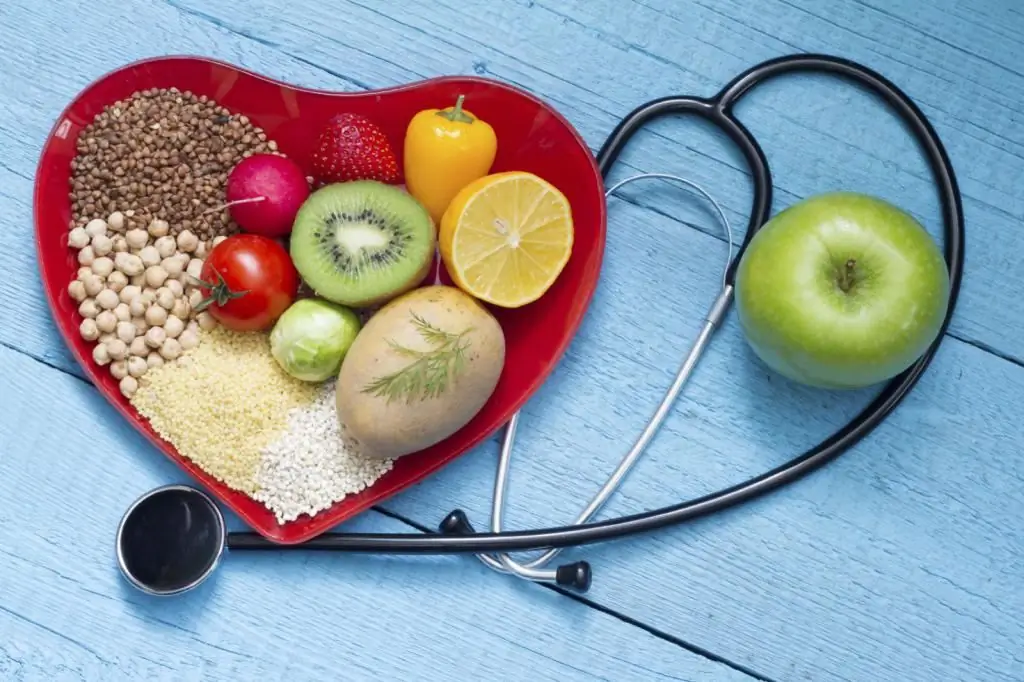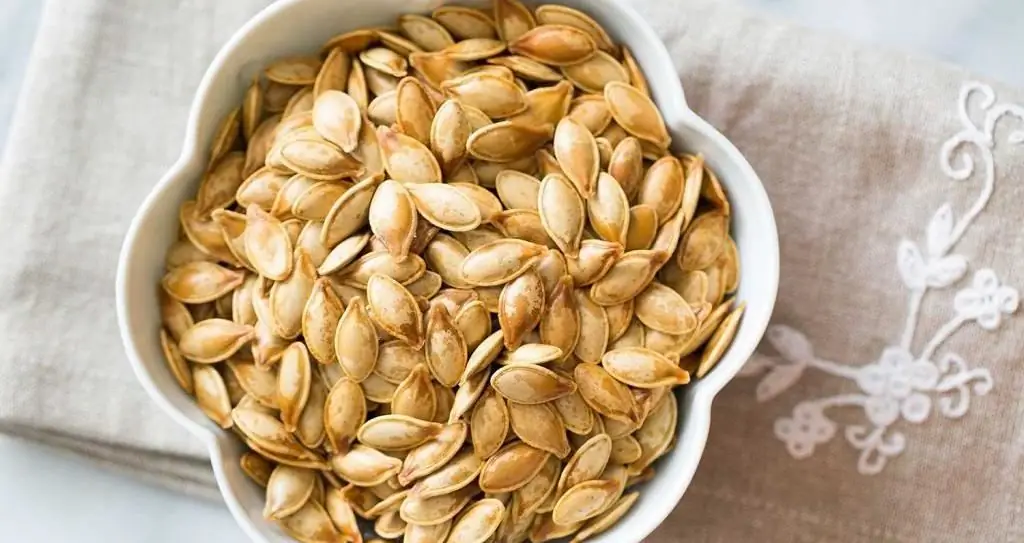2025 Author: Isabella Gilson | [email protected]. Last modified: 2025-01-23 12:50:39
Urticaria is a disease in which red inflammation and blisters appear on the skin, causing itching and burning. For recovery, a diet for urticaria is of great importance. The menu of a sick person should exclude all products that cause an allergic reaction. Only proper nutrition, along with taking medications prescribed by a doctor, can provide an early relief from unpleasant symptoms. A diet for hives should contain only hypoallergenic foods, but at the same time provide a balance of substances necessary for the body.
Foods prohibited for consumption with hives
The list of what not to eat with hives contains, first of all, allergens to which the body reacts. Products that cause an allergic reaction are divided into groups depending on the degree of risk.
First of all, the hives diet should exclude consumption:
- eggs;
- sweets (honey, chocolate, sweets, confectionery);
- smoked meats and other semi-finished meat products;
- carbonated and alcoholic drinks;
- coffee;
- canned foods;
- some vegetables (tomatoes, red peppers, eggplant, beets);
- citrus and fruits in red and orange;
- pastry;
- nuts.

The second group of products includes less allergenic food, but requires some caution in use. Such products include potatoes, green peppers, peaches, corn, fatty meats.
Features of baby food for urticaria
Diet for hives in children is more strict than for an adult's illness, since the child's immunity is weaker and prone to an allergic reaction. The set of prohibited foods depends on the severity of the disease and the age of the baby. After recovery for a few more weeks, foods that can cause allergies should be excluded.
Diet for hives in children consists of porridge, green vegetables, boiled or steamed. Many nutritionists allow you to cook dried fruit compotes. But first they must be thoroughly soaked and remember that dried apricots and raisins can cause an allergic reaction.

Sour-milk products with low fat content and no artificial additives are allowed. Boiled lean meat is also included in the menu of a sick child.
If the symptoms of urticaria appeared in a breastfed baby, then it is necessary to exclude allergen foods from the mother's diet.
Diet for hivesadults
The list of allowed products for urticaria for adults and children is almost the same. The diet for hives in adults consists of boiled lean meat, porridge cooked in water, stewed vegetables that are not among the prohibited ones. Milk cannot be added to food, but it is allowed to include kefir and other fermented milk products in the diet. Many nutritionists list fish as a safe food for hives, but others say the leaner varieties can be eaten.

Juices are allowed, but only home-made from acceptable fruits and vegetables.
Instead of bread, it is better to buy diet crispbread or biscuits.
During an illness, it is recommended to drink as much pure non-carbonated water as possible, and refuse strong tea.
Some doctors in the acute phase of the disease recommend not eating at all for several days. But prolonged fasting while taking medications that should not be taken on an empty stomach can lead to negative he alth consequences.
What is good to eat with hives
When suffering from urticaria, it is useful to eat foods rich in antioxidants (berries, green tea). Whole-grain bread and cereals (buckwheat, oatmeal, brown rice) are also better to add to the diet due to the high content of B vitamins.
For a successful recovery in the menu you need to include foods rich in zinc. These foods include: celery, dates, asparagus, beef, sesame seeds.

Foods-sources of omega-3 fatty acids is another element of the he althy nutrition system for hives. Sea fish, flax seeds, soybeans - products that not only contain Omega-3, but also many other substances important for the he althy functioning of the body, they will be useful to the patient.

Since a lack of magnesium in the body can contribute to the appearance of hives, it is useful to add brown rice, avocados, beans and lentils to the menu. These foods are sources of magnesium and will help the body fight infection.
Foods high in vitamin C will increase the body's resistance to infection and help deal with hives faster. Especially in large quantities, this vitamin is found in dark green vegetables.
How to make a menu for a patient with urticaria
When compiling a menu for a patient with urticaria, it is necessary first of all to identify the allergen. To do this, a sick person can try to eat a certain product on an empty stomach in the morning and follow the reaction of the body. If allergic rashes do not appear within a few hours, then the product can be added to the diet.
When planning a menu, it is necessary to take into account the body's need for trace elements and vitamins, while excluding prohibited foods. Also, the diet depends on the stage of the disease; in acute urticaria, food is limited to several types of foods that do not cause an allergic reaction.

To create a menu, you cantake advantage of the daily diet developed by dietitians. An example of such a system of therapeutic nutrition is table number 5. The diet helps the body to recover in case of disruption of the functioning of internal organs and restores the body.
During the entire period of the disease, it is necessary to consult with your doctor and agree on a hypoallergenic menu with him, especially in case of urticaria in a child.
Features of the diet (table number 5) for urticaria
Table number 5 - a diet developed by a Soviet nutritionist, aimed at treating the body with diseases of the stomach, liver, biliary tract. The main goal of the diet is to create a complete diet that allows you not to overload the internal organs and restore their he althy functioning.

The basis of the diet is vegetable soups, boiled cereals, beef (lean), young turkey and chicken. Therefore, it will be useful to follow a diet with hives, eliminating some possible allergens. All products are steamed or boiled. The food that makes up such a diet is easily digested and has a beneficial effect on the functioning of the body.
Nutrition tips for hives
The hives diet should be based on steamed or boiled food. Before cooking, cereals must be soaked for 12-16 hours. It is better to boil the meat twice before eating.
In chronic urticaria, it is more convenient to keep a food diary to fix the name and number of allconsumed products. Keeping such a diary helps to identify food allergens and gradually introduce new foods that do not cause an allergic reaction.
During the acute phase of the disease, it is better to stop eating during the day and drink only non-carbonated water. In the future, when relief comes, it is recommended for some time to make a menu of light vegetable soups and cereals.
The intake of a complex of vitamins during the period of illness is possible only with the agreement of the doctor.
Nutrition after recovery
After recovery, it is worth sticking to the old diet for a while and introducing new foods into the menu very carefully to avoid re-disease.
A strict diet is not required, but any contact, even mechanical, with the allergen product should be avoided. You should beware of any additives and dyes, choosing only natural products.
In the future, it is necessary to inform doctors about the transferred urticaria, as some medications can cause the disease to reappear.
When using cosmetics, it is better to choose hypoallergenic ones. Also, if possible, limit contact with household chemicals or use natural cleaning products.
Recommended:
Diet for pyelonephritis in adults and children

Pyelonephritis is an infectious disease of the kidneys. Due to physiological characteristics, women and children most often suffer from them. It can also affect older men who have been diagnosed with diabetes mellitus or prostate adenoma. In this case, the success of treatment largely depends not only on the right medications, but also on the observance of a special diet for pyelonephritis - table 7
Diet for pancreatitis for adults and children. Proper diet - pancreatitis successful treatment. Diet after pancreatitis

In medicine, pancreatitis is understood as a disease in which inflammation of the pancreas itself occurs. It carries a lot of important functions necessary for the normal functioning of the whole organism. For example, it supplies a large number of various enzymes to the small intestine for the sequential breakdown of proteins, carbohydrates, and fats. In addition, the pancreas produces a number of hormones, including insulin and glucagon
Diet number 10 ("table number 10"): what you can, what you can not eat, a sample menu for the week

Who needs such a diet? Solved tasks. What is the diet based on? Types of cholesterol: harmful and beneficial. Compliance with the principles. related rules. Required Substances. What can and cannot be eaten? Weekly menu. Recipes
Pumpkin seeds: benefits and harms for children and adults, how to take, daily dose

What are the benefits and harms of pumpkin seeds? How to take this remedy and in the treatment of which diseases they are especially needed? All this further
Diet for pancreatic pancreatitis: menu for adults and children

In our time, many people are faced with such a disease as pancreatitis. This happens because we do not always buy high-quality products in supermarkets and shops. Also, the disease can overtake if you do not eat properly. For example, you eat chips, crackers and other not very he althy foods. If you have already encountered such a disease in a mild form, then this article has an approximate diet for pancreatitis

